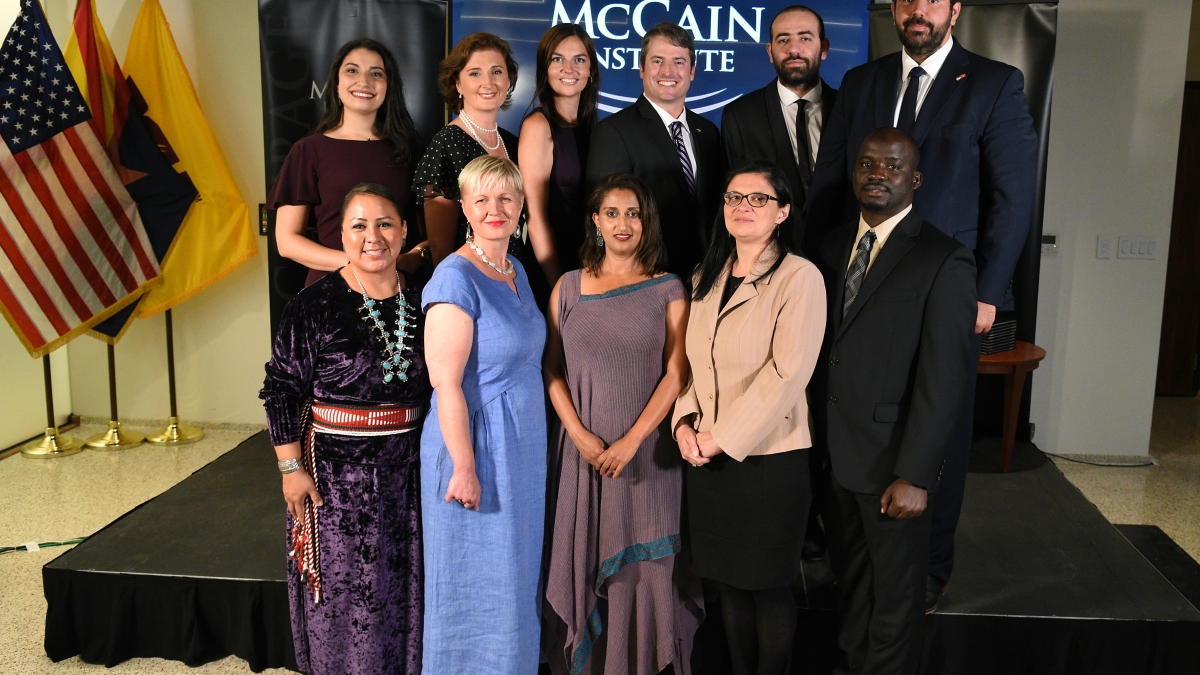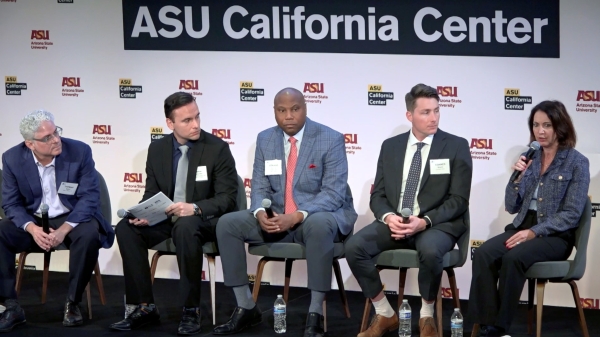McCain Institute hosts 2019 Next Generation Leader Cohort graduation ceremony

The McCain Institute's Next Generation Leaders (NGLs) 2019 Cohort pose with Lt. Jack McCain before the graduation ceremony at the McCain Institute. The ten NGLs completed the 10-month intensive leadership training program and will implement their Leadership Action Plans in their home environments to bring about positive change.
The 2019 Next Generation Leader cohort at the McCain Institute for International Leadership at Arizona State University has graduated from its 10-month intensive leadership training program.
After finishing their yearlong placements in organizations relevant to their goals, this year’s Next Generation Leaders now head back to their home environments to implement their Leadership Action Plans — putting the values-driven leadership skills honed during their time with the McCain Institute into practice to bring about positive change.
“I’m extremely proud to join a global network of outstanding character-driven leaders and advocates for core values of security, economic opportunity, freedom and human dignity,” Next Generation Leader Sokayna El-Allam said. Originally from Morocco, El-Allam’s Leadership Action Plan involves collaborating with local and international stakeholders and launching entrepreneurial initiatives that focus on international development and human rights.
On leave from active duty in the Navy, Lt. John S. McCain IV used his keynote address to tell the graduates, “When I read each of the biographies and exploits of you, the graduates, and now that I’ve gotten to sit down with you, I get to know a diverse, daring and driven group of experts in their respective fields.”
McCain also added three pillars of advice for the graduates: “First, be a good person. Second, do your job. Third, be a smart heretic or foster them.”
Leadership Action Plans from some of the other graduating Next Generation Leaders include:
• Modou Sowe, The Gambia: Seeks to build competent leadership and professional skills to support women and youth in the agricultural value chain for sustainable development while indirectly supporting the government’s efforts to address its challenges of food insecurity, high dependency ratio and the unemployment of women and youth.
• Abdalaziz Alhamza, Syria: Seeks to empower the next generation of Syrians to become compassionate and informed leaders in their own communities and to rebuild the country based on the principles of freedom, dignity, truth, justice, unity and peace.
• Aliz Pocsuvalszki, Hungary: Seeks to focus on education through challenging the long-standing practice of school segregation and to work toward a better, more inclusive system which guarantees access to education to all marginalized groups in Hungary.
“We are extremely proud of the accomplishments of our 2019 cohort and have full confidence that they will take on the implementation phase of their Leadership Action Plans with great passion and determination,” said Ambassador Michael Polt, the program’s senior director.
The 2019 Catalyst Grant winners were also announced at the Next Generation Leaders graduation. Catalyst Grants support and encourage top achievement in the implementation of an Next Generation Leaders' Leadership Action Plan. An annual monetary award of up to $5,000, the grant goes toward increasing the impact an action plan in his or her home environment. The grant winners were:
• Dael Dervishi, Albania, Next Generation Leader cohort 2017
• Edlira Gjoni, Albania, Next Generation Leader cohort 2018
• Erkaiym Mambetalieva, Kyrgyzstan, Next Generation Leader cohort 2018
• Konstantin Popkov, Russia, Next Generation Leader cohort 2015
Partners and supporters in the Next Generation Leader program include:
Placement sites: East-West Institute, DigitalUndivided, Border Network for Human Rights, Denver International Airport, Cry3Con at ASU, City Year New Orleans, the Public Service Academy at ASU, Center for Court Innovation, Community Alliance with Family Farmers and the Department of Health and Human Services
Sponsors: ASU’s President’s Office, Baltic American Freedom Foundation, OCP S.A., Robert Bosch Stiftung, Starr Foundation, Carnegie Corporation of New York, Freeport-McMoRan
More Law, journalism and politics

TechTainment conference explores the crossroads of law, technology, entertainment
What protections do writers, actors, producers and others have from AI? Will changing laws around name, image and likeness (…

How to watch an election
Every election night, adrenaline pumps through newsrooms across the country as journalists take the pulse of democracy. We…
Law experts, students gather to celebrate ASU Indian Legal Program
Although she's achieved much in Washington, D.C., Mikaela Bledsoe Downes’ education is bringing her closer to her intended…